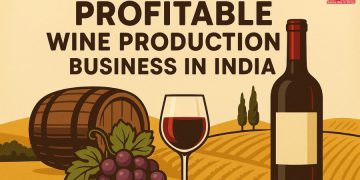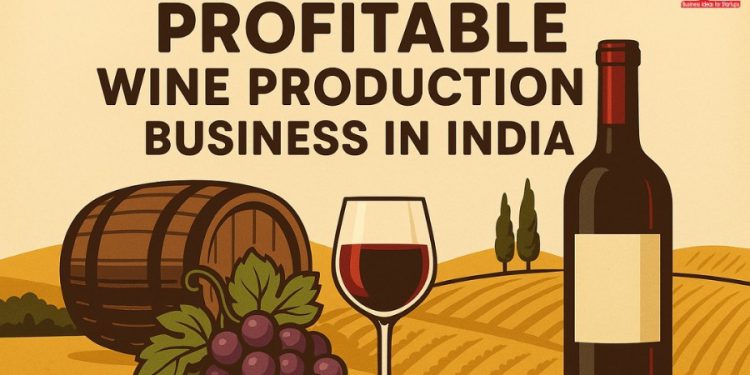The business of wine production in India has transformed from a mere luxury niche to an area of agribusiness and specially beverages. Wine is now served in fine dining restaurants in metropolitan areas and is becoming a popular choice among urban Indians. Global exposure, health consciousness, changing socio-cultural factors, and the upper-middle class population have fueled the increase in demand of wine. Because of this, wine entrepreneurship has surfaced as a business that integrates agriculture with agronomy, lifestyle branding, and processing.
Wine stands out due to the two separate categories it can be placed in- agricultural and luxury. It’s viticulture composes gives it relevance for the deep rural economy while fine dining alongside hospitality resturaunts enable it to be sold as a high mark-up retail product. There is also growing coverage from state governments as wells as tourism policies for wine parks and micro-wineries to enable the construction of sustainable, scalable businesses aimed to domestic and international tourists.
Market Overview and Shifting Consumer Preferences
Wines, both red and white, are critical contributors to the sustained double-digit CAGR growth of the Indian wine market which is currently valued at over ₹2,500 crores. Even though wines have a smaller market share compared to beer and spirits, the wine industry is supported by a steady consumer base who is loyal, qualitive, and willing to experiment with different options. Wine consumption in India is presently limited to urban clusters like Mumbai, Delhi, Pune, Bengaluru, and Goa. However, many tier-2 cities are coming up as robust markets, especially with younger working class women.
Sales of red wine continue to dominate the market due to its perceived health advantages and accompanies Indian food very well. Still coastal regions have fairy rapid white and rosé wine sales during warm weather. Sparkling wines are now introduced as casual lifestyle beverages compared to previously viewed occasional celebratory drinks. Furthermore, the early signs of premiumization are also being observed in the market as customers are showing interest in varietals, terroir-specific wines, and wine tourism experiences.
Choosing the Right Location and Vineyard Setup
As with any activity in a business, location is a critical aspect of the wine production business. Wineries in India have been most successful in regions with distinct wet and dry seasons, moderate winters along with altitude help preventing extreme heat during grape ripening phase, have always shown promising results. Maharashtra has had the upper hand in the country’s wine production being over 60% of its share, with Nashik being referred to as the “Wine Capital of India”. Karnataka has also shown potential in the Nandi Hills region. Even non-traditional ones like Arunachal Pradesh, Tamil Nadu ,and Himachal Pradesh have started experimenting with wine friendly grape varieties.
Most successful vineyards claim to have an ideal setup of around 10 to 20 acres of land, claiming especially hilly regions showcase natural sunlight exposure and drainage are posses sloped topography. Optimum drip irrigation helps in regulating moisture levels without causing waterlogging which is essential in preventing drowning of the crops. Generally assuming irrigation is not a problem, grapevines become commercially productive in 3 years from the date of plantation. With early cash flow planning and income minimizing from renting land, contract farming helps a lot during the initial phase of the business. Those not wanting to wait can opt for contracting with existing growers or purchasing the grapes directly from them at the set agreements.
Project related to this articles
Regulatory and Licensing Framework
The licensing procedures pertaining to the alcohol business in India is done at a state level, which in turn makes the operations of the wine production business more complicated than it has to be. The winery license is the most crucial one and it is granted by the local state’s excise department. In more progressive regions, for instance in Maharashtra where state authorities are more proactive towards the promotion of wine production, the issuing of licenses is more simplified and tends to come along with lesser excise duties or infrastructural assistance.
Some of the other notable approvals are the requisite food license for the wine and bottling business from FSSAI, GST Registration, State Pollution Control Board clearance for waste effluent bottling, and labeling. Filling out the application form for selling wine must undergo a multi approval process, alongside receiving label approval for every single version of wine, which is done within a set timeframe. Entrepreneurs should expect to deal with a lot of legal documentation concerning disclosure, and interminable works, together with the checklist of mandatory inspections, and paperwork while waiting for the grant of the license and consider hiring a local lawyer who understands wine business regulations.
Investment In Infrastructure and Equipment
Setting up a winery from scratch and building all the infrastructure necessary for the wine production steps requires a significant investment in facilities. Facilities should include covered spaces for grape processing, temperature-controlled rooms for fermentation and barrel aging, storage areas for raw and finished products, bottling and labeling sections, as well as an onsite wine tasting area for retail outlet if desired.
One of the largest expenditures for a winery are purchase costs for equipment. The primary and most important components consist of de-stemmers, crushers, fermentation tanks (commonly stainless steel), imposing oak barrels or steel tanks for aging, filtration units, pumps, bottling lines, and quality testing instruments. Control of temperature and humidity during fermentation and aging is critical. For enhanced wineries, equipment from Italy or France is preferred. However, high-end models are also available from Indian manufacturers, making them ideal for smaller setups unprecedented.
The Winemaking Process: The Wonderful Combination Of Science and Art
The grapes are harvested from around January to March, after which they are brought to the winery for sorting and crushing. In the production of red wine, juice is fermented with the grape skins because color and tannins are extracted as a wine by-product. With white wines, fermentation occurs after the juice is separated from the skins. After this, yeast is added and the fermentation epitomizes the phase of a process during which sugars available in juice are converted to alcohol by yeast. Depending on the style of the wine, this stage can take anywhere from several days to a couple of weeks.
Post fermentation, the wine is racked off of sediments, aged in oak barrels, or kept in stainless steel tanks to retain freshness. Aging can take anywhere from three months to two years. The formerly oven, taste, and alcohol strength is checked and for flavor, acidity, and sweetness is filtered and readied for bottling. The different stages of wine undergo different steps, which include labeling, compliance tests, capping, and bottling, when the wine is clean of other grapes. After the testing and censuring for capping, the bottle can be sent off for distribution.
Thoroughly Developed Financial Cost Plans and Working Capital Investments
To maximize production, a small wine business with an annual output of 50,000 bottles will need to invest between ₹2.5 crores and ₹3.5 crores. Vineyard development is projected between ₹40-50 lakhs over a 2-year period. A bare-bones winery setup will cost an additional ₹1-1.2 crores while basic equipment will require infrastructure like the building, tank, and utility setup which is projected at ₹50-70 lakhs. Branding, licensing, and legal provisions with unexpected additional costs may add up to ₹25-40 lakhs. In working capital, wages, utility payments, outsourced grape acquisition, and packaging will require an additional ₹40-50 lakhs for marketing in the first year.
Considering the revenue, net income can hit up to ₹3.5 crores if 50,000 bottles are sold annually and retailer markup per bottle is averaged at ₹700. Net income increases to 50% if sold via direct channels like retail outlets or wine tourism. Markups drop to 30-35% when sold to dealers, restaurants, or liquor shops. Business can achieve break-even within in 4-5 years assuming income from tourism and organically grows are added.
Branding, Distribution, and Consumer Interaction
The business of producing wine is distinct from other industries in that it depends mostly on brand image and experience marketing. The marketing of alcohol is limited by law, and as a result, wine brands often turn to surrogate marketing such as sponsoring events, CD sales, tasting events, partnering with restaurants, and crafting a narrative around the wine’s origins.
Creating a channel for pop-up tastings, wine clubs, and your website can help create customer loyalty. Participation in wine exhibitions, food festivals, and hospitality fairs allows you to meet potential distributors and broaden your market exposure. The customers’ perception of the wine’s value is shaped significantly by the labeling, aesthetic of the bottle, and even the brand name.
Related: Want to Start Business of Wine? Here is Good Profitable Ideas for you that How to Start Production of Wine from Pineapple and Ginger
How NPCS Can Help You Start Your Wine Business
Tailored Wine Business Plans Through DPRs
NPCS assists entrepreneurs in animating project concepts by helping form business plans through their wine production DPRs (Detailed Project Reports) which captures the nuances of the market, costs, technology operations, plant layout, and other essential elements. With decades of experience in agri-processing, fermentation industries as well the food & beverage world, NPCS custom designs consultancy for micro-wineries, estate vineyards, private label wines, and ample wine tourism projects.
Comprehensive Support Services
NPCS has a comprehensive list of services that include financial feasibility, documentation for lending institutions, regulatory and compliance checklists, as well as sourcing suppliers for equipment. Entrepreneurs partnered with NPCS are provided with a clear pathway and a realistic timeline to launch their comprehensive wine production venture from ROI estimations, detailed execution documents, and many more.
The Craft Behind Wine Making
This line of business, like fine wine, requires time and passion to cultivate.
Wine production isn’t merely about crafting a product; it’s about masterfully shaping an experience. The domestic Indian wine market has tremendous potential and is poised for new and bold entrepreneurial stories. These stories will embrace both domestic and international audiences. From premium boutique wineries to abundant scalable contract wine producers, India offers diverse locations and opportunities. A thorough analysis of product strategy, compliance frameworks, and marketing can deliver astonishing results.
Turning Dreams into Wine Ventures with NPCS
With the aid of consultants like NPCS, integrating conventional agriculture, contemporary winemaking, and bold marketing can ensure that your winery dream becomes a well-established business in the near future.


























